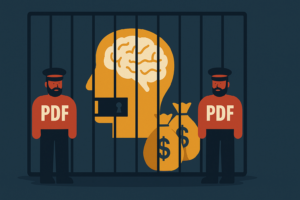
Most organizations are sitting on a goldmine — and don’t even know it.
That’s because up to 90% of business content is unstructured, often locked away in static PDFs: reports, brochures, research, and editorial archives that are hard to access, hard to share, and even harder to monetize.
We generate it. We store it. But we rarely unlock its value
Why PDFs Are Holding Us Back
PDFs were built to preserve layout — not to be responsive, searchable, or accessible. They work fine for print, but in a digital-first world, they fall short:
- Search engines struggle to index them
- Mobile devices can’t display them well
- Accessibility is limited or non-existent
- AI tools choke on long, complex layouts
Even the best AI models today — GPT-4, Claude, etc. — don’t truly understand what’s inside PDFs. They miss context, skip formatting, and can’t navigate across tables, sidebars, or embedded images.
A Missed Opportunity Across Industries
This isn’t just a tech flaw. It’s a strategic blind spot affecting:
🔹 Publishers: Rich editorial content ends up flattened, invisible to search, and impossible to reuse across platforms
🔹 Universities: Decades of valuable research buried in inaccessible archives
🔹 Tourism boards & cultural orgs: Beautiful brochures stuck in unreadable formats
🔹 Corporates: Internal magazines and reports that nobody reads because they’re hard to reach or use
The Solution: Make Content Work Harder
Unlocking PDF content isn’t just about digitization — it’s about transformation. Imagine turning static files into:
✔ SEO-optimized web articles
✔ Mobile-friendly reading experiences
✔ Accessible and ADA-compliant formats
✔ Modular content packages for repurposing
This shift allows teams to generate new value from old content — increasing traffic, engagement, discoverability, and ROI.
OK! So Why Aren’t We All Doing This
If the limitations of PDFs are so obvious, why haven’t more organizations tackled the problem head-on?
The reality is simple: it doubles the workload.
Most publishers and content teams still design with print in mind. Shifting that same content into a responsive, digital format requires a different layout, a different mindset — and often, a different skillset altogether. It’s not just about copy-pasting into a CMS; it’s about rethinking how that content is structured, consumed, and optimized across devices.
This disconnect has left many organizations stuck: either continue producing beautiful, static PDFs or invest significant time reworking that content for digital platforms — often manually, and with limited resources.
But that’s changing.
An AI-powered workflow like Experios can intelligently extract and restructure content from press-ready PDFs into dynamic, web-friendly formats. Instead of duplicating effort, these tools bridge the gap between print and digital, freeing up editorial teams to focus on storytelling — not formatting.
Experios uses sequential content extraction to preserve the article flow while outputting fully responsive layouts — making it possible to deliver both print-ready and digital-ready formats without starting from scratch.
For publishers and organizations with content-rich archives, this approach doesn’t just save time — it unlocks entirely new value from the work they’ve already done.
The Bigger Picture
Solving the PDF problem might sound small. But so did indexing the internet.
Unlocking content trapped in PDFs could power the next wave of innovation in digital publishing, internal communications, research, and more.
It’s not about creating more — it’s about rediscovering what you already have.
The knowledge is there. The tools are here. It’s time to set it free.
If you’re working with large archives or PDF-based workflows, I’d love to hear how you’re tackling this. Or feel free to reach out if you’re curious what Experios can do.
#DigitalTransformation #Publishing #ContentStrategy #AI #PDF #Experios #KnowledgeManagement #WebPublishing







